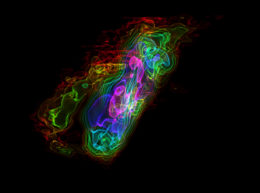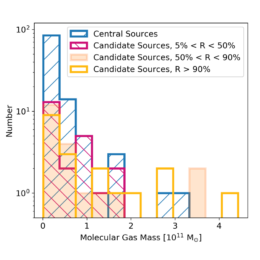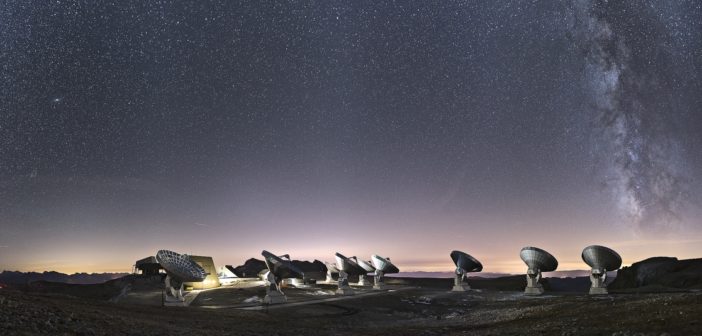The rate at which galaxies form stars is governed in part by how much star-making material — namely, cold molecular gas — is available. So how has the availability of molecular gas changed with time?

A map of the carbon monoxide in the galaxy NGC 253 based on observations taken by ALMA. Purple regions correspond to brighter CO emission while red regions correspond to fainter CO emission. [NSF/Erik Rosolowsky/University of Alberta]
Running Out of Fuel
Most galaxies aren’t forming new stars like they used to. In fact, star formation rates across the universe peaked at redshifts (z) of 1–2, or between 8 to 10 billion years ago. This time of frenzied star formation is still not fully understood, so it’s valuable to probe the availability and efficiency of star-formation fuel over the lifetime of the universe.
What fuels star formation? The typical answer is cold, dense molecular gas, which can be identified by associated emissions at particular wavelengths. Emissions from carbon monoxide (CO) are especially useful in this regard.
Previous searches for molecular gas using CO emissions have shown that galaxies at z ~ 2 have more gas than galaxies local to us (at z ~ 0). However, most of these high redshift galaxies were selected based on their appearance at other wavelengths, which could bias our understanding of the availability of molecular gas.

One of the newly identified CO sources as seen in PHIBSS2 (top) and the COSMOS survey (bottom). In the top panel, regions with higher signal to noise are in red. In the bottom panel, the red oval is a measure of the instrument resolution, and the white contours and red crosses correspond to detections. [Adapted from Lenkić et al. 2020]
Searching in the Dark
The PHIBSS2 observations leverage the Northern Extended Millimeter Array, a large array of radio dishes located on the Plateau de Bure in the French Alps. The total volume being searched was about 200,000 cubic megaparsecs, or 6 x 1063 cubic kilometers. The observations were made for a study similar to the one being conducted by Lenkić and collaborators, but the galaxies observed were selected based on their masses. The spatial extent of the observations was large, making them well suited for a search for other CO sources in each image.
To identify possible reservoirs of molecular gas, Lenkić and collaborators looked for three different emissions associated with CO in the PHIBSS2 data. Once they had found potential sources of CO emission, they then searched corresponding images taken by the Hubble Space Telescope to see if those sources had associated optical (shorter wavelength) emissions as well.

Comparing the targeted sources in PHIBSS2 (blue) with candidate sources color-coded based on their confidence levels, or R. The higher R is, the higher the confidence in the source. [Adapted from Lenkić et al. 2020]
Sources Spanning Across Time
Lenkić and collaborators ended up finding 67 candidate sources of CO emission within z ~ 0.6–3.6, when the universe was between 2 and 8 billion years old. Over half of the candidates have at least one optical detection in the Hubble data. These sources appear similar to other sources of CO emission that were found serendipitously, and they also closely trace the original PHIBSS2 targets.
This new, serendipitous sample will help us to better understand how star-formation fuel is distributed throughout galaxies in the distant universe, and it can be expanded with additional observations that cover a large area of the sky. Lenkić and collaborators note that these kinds of searches could also be done with older observations that weren’t taken for the express purpose of such a search. That would be a challenge, but certainly doable, as demonstrated by this work!
Citation
“Plateau de Bure High-z Blue Sequence Survey 2 (PHIBSS2): Search for Secondary Sources, CO Luminosity Functions in the Field, and the Evolution of Molecular Gas Density through Cosmic Time,” Laura Lenkić et al 2020 AJ 159 190. doi:10.3847/1538-3881/ab7458

